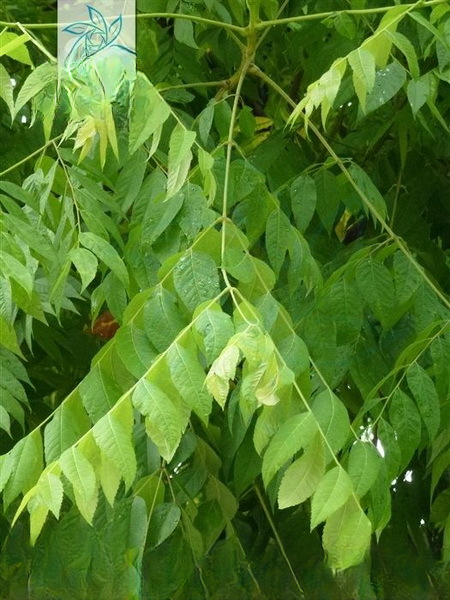Plant knowledge | Arrangement of common flowering trees in gardens
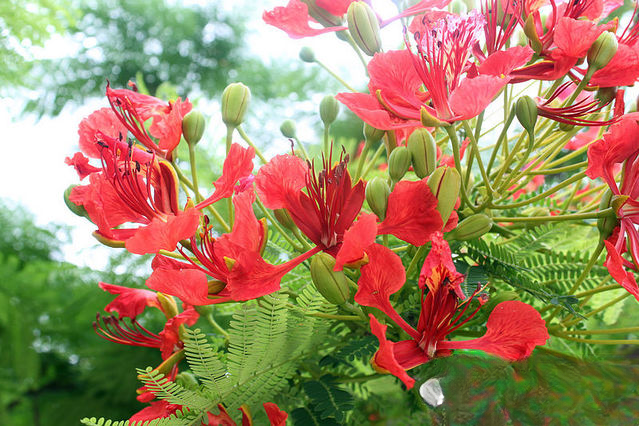
Bauhinia scabra
Other names: Bauhinia bauhinia, red bauhinia, Hong Kong cherry, red bauhinia, foreign cherry
Family: Caesalpiniaceae
Morphological characteristics: Evergreen tree, 6-10 meters high. The leaves are leathery, round or broadly heart-shaped, 10-13 cm long, slightly wider than long, with two lobes at the top, shaped like sheep's feet, with the lobes about 1/3 of the total length, and the ends of the lobes are blunt. The inflorescence is racemose or sometimes branched and panicle-shaped; red or reddish purple; the flowers are as big as a palm, 10-12 cm; 5 petals, 4 of which are arranged on both sides, facing each other, and the other petal is tilted upward, shaped like an orchid; the flower fragrance is similar to the fragrance of orchids, so it is also called "orchid tree". The flowering period is from November to April of the following year.
Distribution of origin: Distributed in Fujian, Guangdong, Hainan, Guangxi, Yunnan and other places, also distributed in Vietnam and India.
Growth habits: tropical tree species, prefers hot, humid, rainy climate, has a certain cold resistance, and can overwinter in the vast areas south of the Tropic of Cancer. Adapts to fertile, moist acidic soil.
Garden use: The tree has a beautiful crown, large and numerous flowers, bright colors and fragrance. It is one of the main ornamental tree species in southern China. It is suitable as a landscape tree, garden shade tree or street tree, and can also be used for seaside greening.
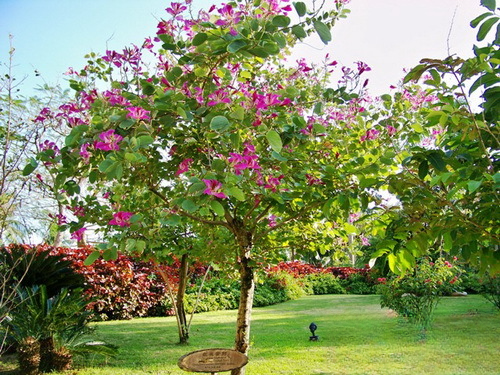
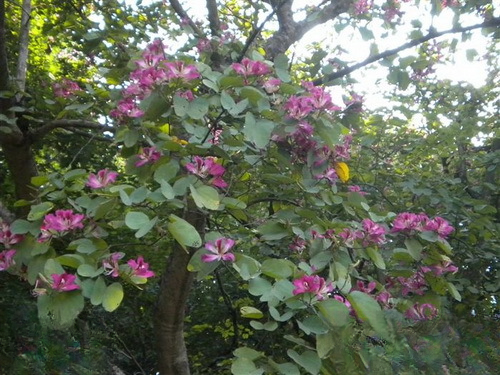
Kapok (Guangzhou’s city flower) and Argentina’s national flower
Morphological characteristics: Large deciduous tree, up to 25 meters high, with grayish white bark, and the trunk of young trees usually has conical thick thorns; branches are flat. Palmate compound leaves, 5-7 leaflets, oblong to long-lanceolate, gradually pointed at the apex, broad or narrow at the base, entire, glabrous on both sides, 15-17 pairs of pinnate lateral veins, raised, with a thinner secondary lateral vein in between, extremely fine and dense reticulate veins, slightly convex on both sides; petiole 10-20 cm long; petiolule 1.5-4 cm long; stipules small. Flowers are solitary in the axils of branches, usually red, sometimes orange-red, about 10 cm in diameter; calyx is cup-shaped, 2-3 cm long, glabrous on the outside, densely covered with short yellowish silky hairs on the inside, 3-5 calyx teeth, semicircular, 1.5 cm high, 2.3 cm wide, petals are fleshy, obovate-oblong, 8-10 cm long, 3-4 cm wide, covered with stellate soft hairs on both sides, but sparser on the inside; stamen tube is short, filaments are thicker, thick at the base, gradually tapering upwards, the upper part of the filaments in the inner whorl is bifurcated, the middle 10 stamens are shorter and unbranched, the outer whorl has many stamens, collected into 5 bundles, each bundle has more than 10 filaments, and is longer; style is longer than stamens. Capsule is oblong, obtuse, 10-15 cm long, 4.5-5 cm thick, densely covered with grayish-white long soft hairs and stellate soft hairs; seeds are numerous, obovate, and smooth. Flowering period is March-April, and the fruit matures in summer
Growth habits: likes warm, dry and sunny environment. Not cold-resistant, slightly resistant to moisture, avoids waterlogging. Drought-resistant, pollution-resistant, wind-resistant, deep-rooted, fast-growing, strong germination ability. The suitable growth temperature is 20-30℃, and the winter temperature is not lower than 5℃. Deep, fertile, well-drained neutral or slightly acidic sandy soil is preferred.
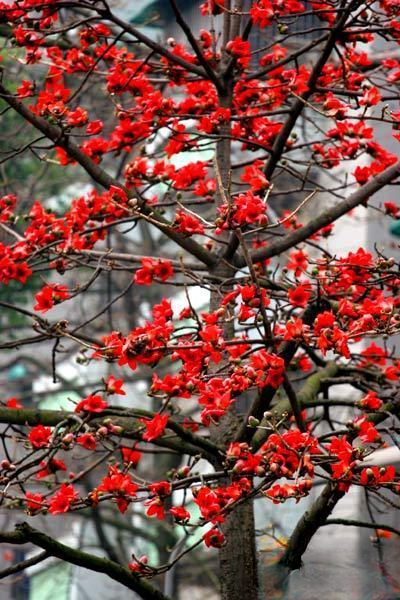
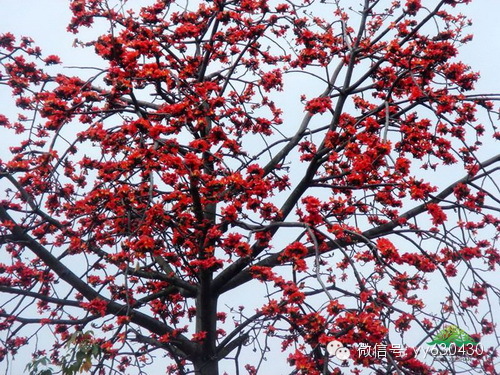
Silk Cotton Tree
Alias: Beauty Tree
Family: Bomdacaceae, Genus: Allocot
Morphological characteristics: Large deciduous tree, 10-15 meters high, with swollen lower trunk, dark green bark on young trees, densely covered with conical prickles, and radially extending side branches horizontally or obliquely. Palmate compound leaves with 5-9 leaflets; leaflets are elliptical, 12-14 cm long. Solitary flowers, corolla light purple, white center; 5 petals, curled, filaments fused into stamen tubes, surrounding the style. Winter is the flowering period. Capsules are elliptical. Seeds mature in the spring of the following year. The crown is umbrella-shaped, the leaves are green, and the trunk of an adult tree is bottle-shaped; in winter, the tree is full of purple flowers, beautiful and attractive, and is a high-quality tree species for garden greening and beautification.
Garden application: The tree has an umbrella-shaped crown, verdant leaves, and a wine-bottle-shaped trunk when mature. In winter, the tree is in full bloom and is purple and beautiful. It is an excellent ornamental tree and a high-level tree species for garden greening and beautification. It can also be used as a high-level street tree.
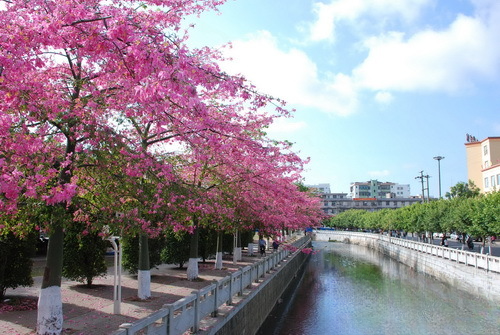
Jacaranda
Family: Bignoniaceae
Genus: Jacaranda
Other names: Brazilian redwood, fern tree
Latin name: Jacaranda mimosifolia
Morphological characteristics: deciduous tree. The crown is tall, 12 to 15 meters high, and can reach up to 20 meters. The leaves are bipinnate compound leaves, large leaves, more than 16 pairs of pinnae, each pinna has 10 to 24 pairs of leaflets, pinnate, closely attached, quite beautiful, and the leaflets are about 6 mm long. Panicle inflorescence, branch end or axillary, bell-shaped flowers, 25 to 35 cm long, lavender, flowering in late spring and early summer. The fruit is a capsule, round and slightly flat, light brown, about 5 cm in diameter. The leaves fall off when flowering. This tree is also known as the blue mist tree because its leaves are like ferns, and the wood is dark brown.
Garden use: It is a foliage and flower viewing tree, and can be used as a street tree, shade tree and landscape tree.
Garden use: It is a foliage and flower viewing tree, and can be used as a street tree, shade tree and landscape tree.
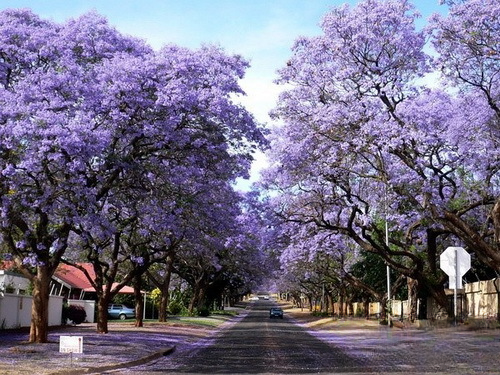
Poinciana
Species alias: red jacaranda tree, phoenix tree, fire tree, red jacaranda, shadow tree, golden phoenix
It is native to Africa and has been introduced and cultivated in Taiwan, Hainan, Fujian, Guangdong, Guangxi, Yunnan and other provinces and regions.
Morphological characteristics: deciduous tree, 10-20 meters high. The bipinnate compound leaves are 20-60 cm long, with 15-20 pairs of pinnae, 5-10 cm long, and 25-28 pairs of leaflets; the leaflets are densely grown, small, oblong, 4-8 mm long, covered with silky hairs on both sides, and blunt at the top. The corymb racemes are terminal and axillary; the flowers are large, 7-10 cm in diameter; the corolla is bright red to orange-red with yellow spots. The flowering period is summer. The pods are slightly sickle-shaped, flat, and 30-60 cm long. The seeds mature in autumn. The Poinciana is a deciduous tree of the Poinciana genus of the Caesalpinia family. It is 15-20 meters high and has a breast diameter of 1 meter. The crown is flat and umbrella-shaped, and the leaves are bipinnate. The flowering period is May-July and the fruiting period is November. The petals are five petals, and the color is bright red with a yellow halo. The flowers are red and the leaves are green, the tree is full of fire, magnificent, and the treetops are full of them, like butterflies flying on it. The tree is broad and umbrella-shaped, with many branches and spreading; the twigs are often covered with short hairs and have obvious lenticels. When the leaves fall in winter, countless leaflets fall like snowflakes. After flowering, long pods are produced, which can be up to 60 cm long. When mature, they are dark brown and woody, containing 40-50 tiny seeds, each weighing only 0.4 grams on average. The seed coat has spots and is poisonous, so do not eat it by mistake.
Growth habits: It likes high temperatures and long days, and must be in full sunlight to thrive. Delonix regia adapts to tropical climates, is drought-tolerant, and can grow in saline environments.
Garden uses: Commonly seen in gardens or as street trees.
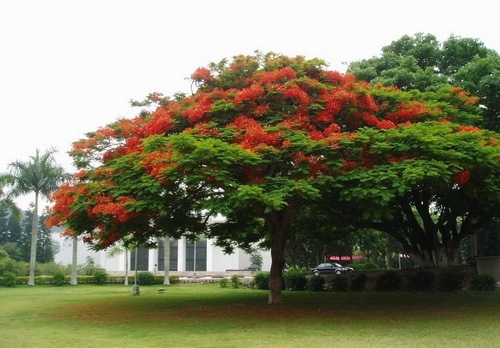
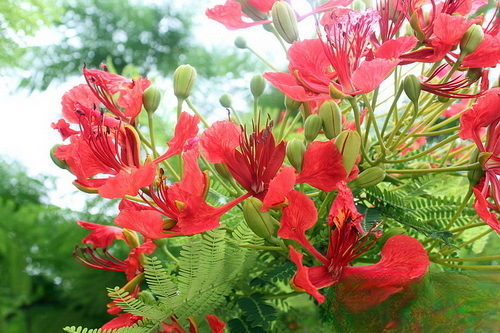
Erythrina crestina
Species name: Erythrina crestina
Scientific name: Erythrina crista-galli L.
Other names: Sea red bean, crown erythrina, ivory red
Family: Leguminosae
Genus: Jacaranda
Morphological characteristics: A small deciduous tree with a height of 2 to 4 meters. The leaves are long ovate, pinnate compound leaves, odd number, 1, 1-2 pairs of ovate leaflets, pinnate lateral veins; trifoliate compound leaves, leathery. The flowering period is about April to July, axillary, racemose, corolla orange-red, the standard petal is obovate and specialized into a spoon shape, the same length as the keel petal, wide and upright, and the wing petals are not fully developed. The remaining petals are almost in a bunch, the stamens and anthers are yellow and naked. The pods are 10 to 30 cm long and contain 3 to 6 seeds.
Growth habits: It likes light and high humidity and humid climate. It has strong adaptability, is drought-resistant, cold-resistant, wind-resistant, and air pollution-resistant. It can be cultivated in any soil and can grow rapidly in full or half sunlight. Garden use
Garden application: The tree is small in shape, suitable for street trees and landscape trees. It can be planted alone, in rows or in groups in gardens, campuses, parks, recreation areas, temples, etc. It can attract butterflies and birds when it blooms.
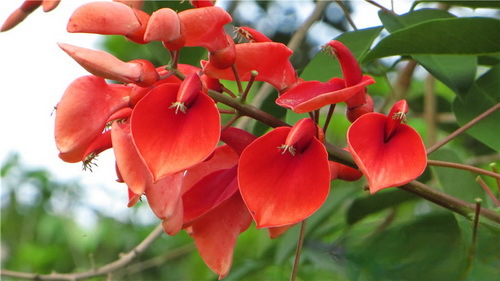
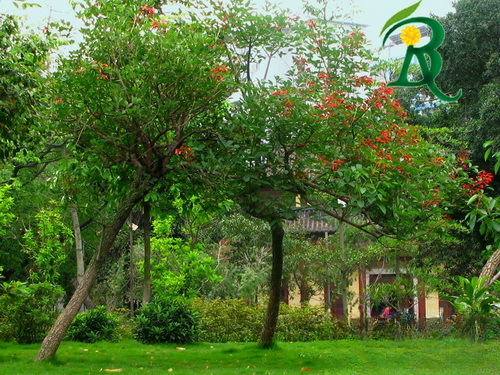
Sophora japonica
Family: Leguminosae
Genus: Cassia
Origin: India, Sri Lanka, Southeast Asia and Oceania
Suitable area: Southeast and southern cultivation
Morphological characteristics: Shrub or small tree. Even-pinnate compound leaves; 2-3 club-shaped glands on the petiole and the rachis between the lowest 2-3 pairs of leaflets; 14-18 leaflets, oblong or ovate, 2-5 cm long, 1-1.5 cm wide, with rounded and slightly concave tips, rounded bases, often oblique, and pink-green on the back with short hairs. Corymbose inflorescences grow in the axils of the upper branches, 5-8 cm long; flowers are yellow or dark yellow, 1.5-2 cm long; 10 stamens, all developed; the anthers of the lower 2-3 stamens are larger; the ovary is hairy. Pods are linear, 7-10 cm long, 0.8-1.2 cm wide. The seeds are slightly constricted, with a beak at the tip. Flowers and fruits are produced all year round.
Growth habits: Sunny, tolerates semi-shade, likes high temperature and humid climate, tolerates early growth, not wind-resistant. Small tree, 5-7 meters high.
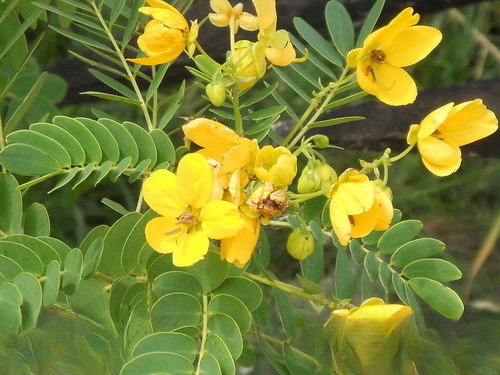
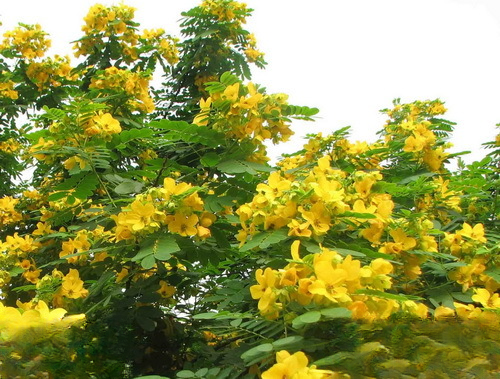
Crape Myrtle
Other names: Lagerstroemia indica, Lagerstroemia indica, Itchy Tree
Category: Deciduous small tree
Morphological characteristics: The tree is 6-12 (15) meters tall, with an upright trunk, dark brown bark, many branches, spreading branches, and round umbrella-shaped. The leaves are large, 10-70 cm long, with short petioles. The leaves are single and opposite, elliptical, oblong or oblong, up to 20 cm long, with sharp tips and entire margins; it blooms from May to August, with terminal panicles, purple flowers, large flowers, 5-7 cm in diameter, 6 lavender petals, and uneven edges; the capsule is spherical, about 2.5 cm in diameter, matures in autumn, and is tea-brown when mature, splitting into six pieces. The calyx has ridges and scaly soft hairs; it blooms in summer and autumn.
Growth habit: Positive plant. Need strong light. Heat-resistant, not cold-resistant, drought-resistant, alkali-resistant, wind-resistant, semi-shade-resistant, pruning-resistant, pollution-resistant, large trees are difficult to transplant. Prefers hot and humid climate, can be cultivated in full or half-sunlight, is not strict in soil selection, wind-resistant, cold-resistant, drought-resistant and barren-resistant.
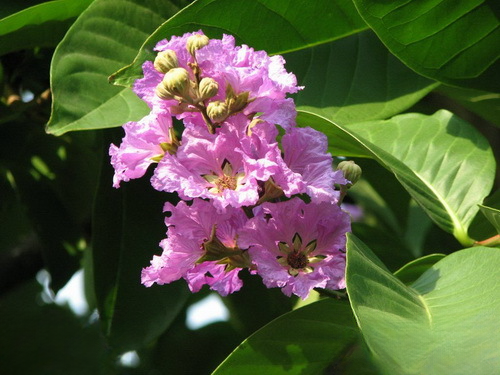
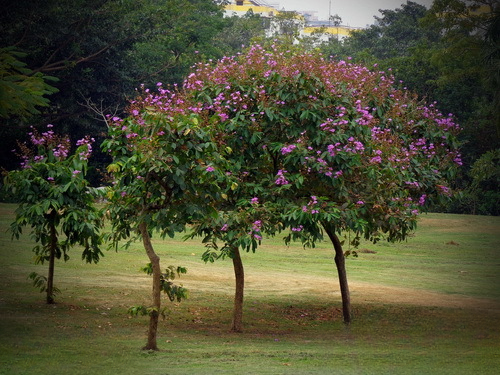
Bauhinia
Other names: Red Bauhinia, Red Bauhinia, Red Bauhinia, Hong Kong cherry blossom
Origin and Distribution: Originated in Guangdong and Hainan. Now cultivated in Yunnan, Guangxi, Guangdong, Fujian, Hainan, and Taiwan; also distributed in India and Vietnam. Due to its high ornamental value, it has been introduced to tropical and subtropical regions of the world.
Morphological characteristics: small evergreen tree, 3-4m high, with alternate, kidney-shaped, very broad leaves. Flowering period: winter to spring, racemose inflorescence, corolla rich purple-red, five petals.
Growth habits: likes light, warm, moist, acidic soil.
Garden application: The flowers are rich and gorgeous, with a long flowering period, and are widely loved. It is suitable for garden greening, shade viewing flowering trees, and can also be used as street trees.
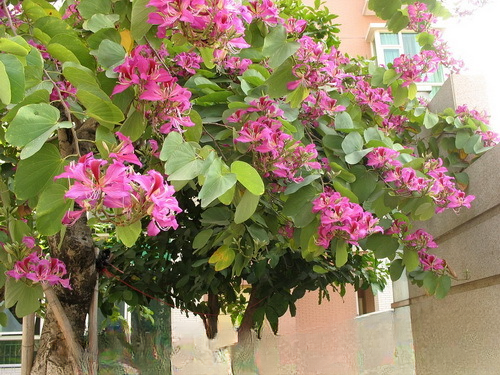
Plumeria
Scientific Name: Plumeria rubra 'Acutifolia'
Other names: Burmese gardenia, egg yolk flower, big season flower, Indian jasmine
Family: Apocynaceae, Plumeria
Origin and Distribution: Originated from Mexico, America. It has been introduced for cultivation in Guangdong, Guangxi, Yunnan, Fujian and other provinces. It needs to be cultivated in greenhouses in the Yangtze River Basin and the areas to its north. It is the national flower of Laos. It is the city flower of Zhaoqing, Guangdong.
Morphological characteristics: deciduous shrub or small tree. 4-5 meters high. Thick and fleshy branches, thick and fleshy twigs; large, alternate leaves, pinnate veins; thick paper, mostly clustered at the top of the branches, veins connected to form a side vein near the leaf edge; several flowers clustered at the top of the branches, corolla tubular (funnel-shaped), about 5-6 cm in diameter, 5-lobed; five petals stacked in a circle, like a paper windmill folded by children. The outside is milky white, the center is bright yellow, very similar to egg white wrapped in egg yolk, hence the name, and the smell is very fragrant. In addition, there are two colors, red and yellow. Plumeria blooms in summer, with a fresh and elegant fragrance; after the leaves fall, the bare trunk is naturally curved and beautiful. It is suitable for planting in courtyards and grasslands, and can also be potted. The flowers are fragrant, can be used to extract spices, or dried for beverage preparation, and can also be used for medicinal purposes. The period is from May to October. The fruit is a pair of follicles; there are many seeds, with membranous wings at the top and no seed hairs. Growth habit
Growth habits: It likes high temperature, high humidity, sufficient sunlight and good drainage. It is strong and drought-resistant, but afraid of cold and waterlogging. It likes acidic soil, but also resistant to alkalinity. Deep, fertile, well-permeable, and organic-rich acidic sandy loam is the best place for cultivation. The suitable growth temperature is 23℃ to 30℃. It can withstand extreme high temperatures of 40℃ in summer. When the temperature drops below 15℃, the plant begins to shed its leaves and go dormant until around April of the following year.
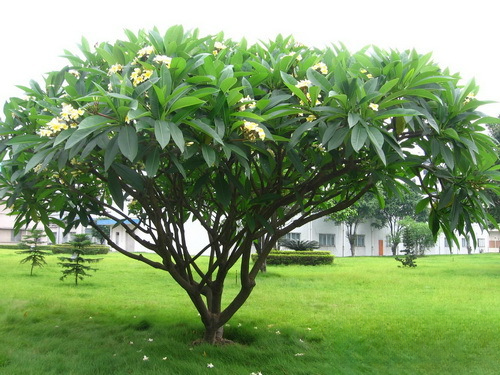
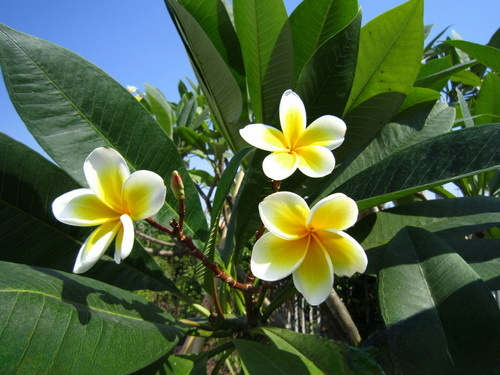
Salix palinurus
Other names: Weeping Callistemon, Bottlebrush Tree
Family: Myrtaceae
Genus: Callistemon
Origin: Native to Australia.
Morphological characteristics: It is a very cold-resistant and attractive shrub with gray bark, spike-shaped inflorescences, soft and drooping branches and inflorescences, flowering in April, woody capsules. Propagation and cultivation: sowing and cutting propagation.
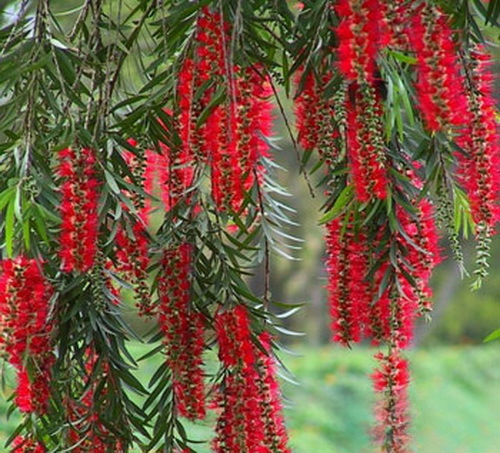
White Orchid
Latin name: Michelia alba
Other names: White Burmese osmanthus, white orchid, Burmese osmanthus
Family: Magnoliaceae Michelia Morphological characteristics
Morphological characteristics: an evergreen native plant growing in southern China. An evergreen tree, up to 17-20 meters tall, with grayish-white bark, evergreen young branches, and few branches. Single leaves are alternate, relatively large, oblong or lanceolate, entire, and thinly leathery. Flowers are solitary in the axils of the current year's branches, and their buds resemble the tip of a brush. They are white or slightly yellow and very fragrant. The flowering period is from June to October, with the peak in summer.
Living habits: It likes an environment with sufficient sunlight, warm and humid, and good ventilation. It is not cold-tolerant, shade-tolerant, and afraid of high temperature and strong light. It prefers well-drained, loose, fertile, slightly acidic soil. It is most afraid of smoke, typhoons, and waterlogging. It blooms all year round in southern China under suitable temperature conditions. The tree has a beautiful posture, clear green leaves, white flowers, and a fragrance like orchids.
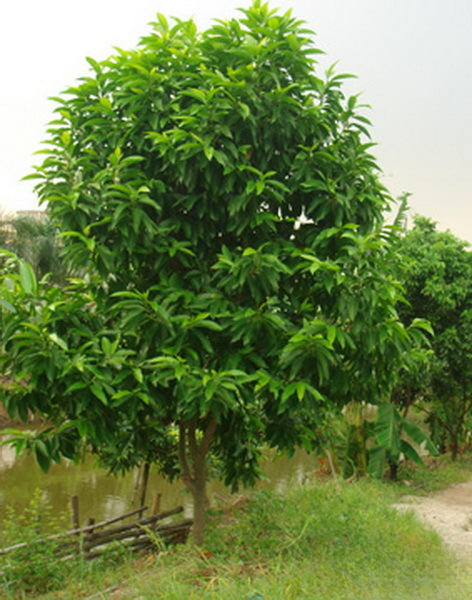
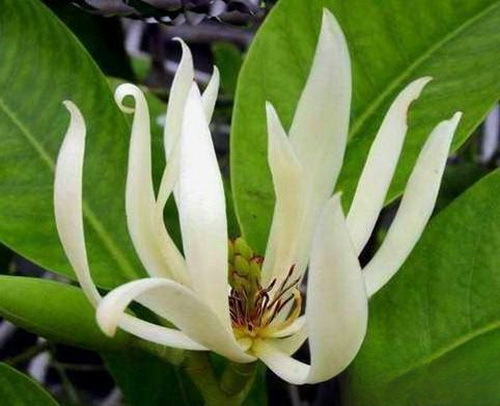
Callistemon
Bottlebrush Tree
Family: Myrtaceae
Genus: Callistemon
Morphological characteristics: A shrub of the family Rhapis, 1-2 meters high; the bark is dark gray and not easy to peel off; young branches and leaves have white soft hairs. Leaves are alternate, linear, 3-8 cm long, 2-5 mm wide, hard, glabrous, with transparent glandular dots, obvious midrib, and sessile. Spike inflorescence with many densely planted flowers; the flowers are red and sessile; the calyx tube is bell-shaped, with 5 lobes, falling off; the petals are 5, falling off; the stamens are numerous and red; the ovary is inferior. The capsule cracks at the top.
Growth habits: Callistemon is a positive tree species, likes warm and humid climate, can withstand scorching sun and heat, is relatively cold-resistant, likes fertile, acidic soil, and can withstand thin land. It has strong germination ability, is resistant to pruning, and is resistant to air pollution. The seedlings can overwinter in the open field locally, can withstand low temperatures of -10℃ and high temperatures of 45℃, and the optimum growth temperature is about 25℃. It is not strict with water requirements, but grows faster under humid conditions. Because it is extremely drought-resistant and barren, it can also be cultivated in barren mountains or forest parks in the suburbs of towns.
Garden application: The shape of the red melaleuca plant is cool and beautiful. Every year in late spring and early summer, the red flowers of the tree are full of flames. When in full bloom, thousands of stamens form a bright red bottle brush, which is very unique. The flowering period is long, the number of flowers is large, and the plant is strong and easy to cultivate. It is deeply loved by people and is suitable for garden beautification. It is a high-end garden beautification flower tree, street tree, and landscape tree. It can also be used as a windbreak, cut flower or large potted plant, and can be pruned to become a noble bonsai. The red stem layer flower has a peculiar shape and bright and beautiful colors. When it blooms, the red flowers of the tree are called a strange flower of southern flowers and trees. It is very popular as a flower arrangement bouquet. The red melaleuca is the preferred tree species for garden flower trees and street trees .

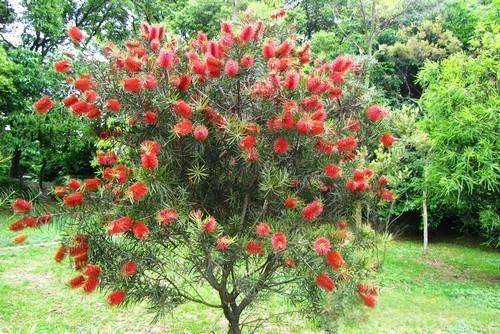
Worry-free tree
Academic name: Poor dives Pierre
Other name: Flame Flower
Family: Leguminosae, Asoka
Morphological characteristics: Small tree, leaves 8-30 cm long, oblong or oblong-lanceolate. 5-10 meters high. Pinnate compound leaves, petioles are very soft and cannot support the leaves, so the young leaves are drooping, and look like a purple cassock wet by rain. It blooms from March to May every year, and the bark and fruit can be used as medicine.
Ornamental application: The branches are majestic, the leaves are large and green; the inflorescence is large and the flowering period is long. The flowers are numerous and dense, red like flames, and it is an elegant woody flower. It can be widely used for greening the garden.
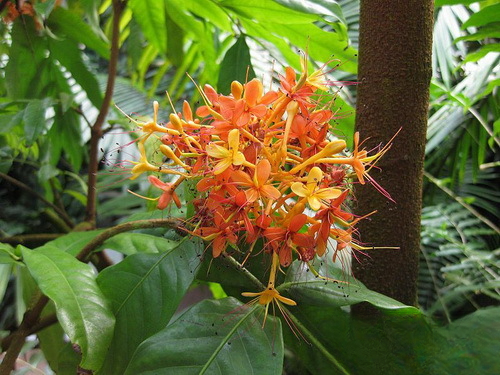
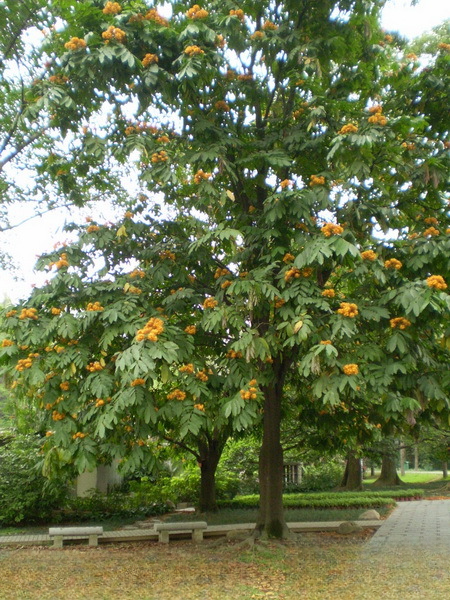
Ilex ironii
Family: Aquifoliaceae
Genus: Holly
Morphological characteristics: It is an evergreen tree of the Aquifoliaceae family. Its leaves are thin and leathery, ovate or obovate-elliptic, entire, and glabrous on both sides. Cymes or clustered inflorescences are axillary and glabrous. The flowers are small, unisexual, dioecious, yellow-white, and fragrant. The berry-like drupes are oval, shiny, and deep red. The flowering period is March to April, and the fruit ripens in November. The fruit turns from yellow to red after flowering, and the red fruits are numerous in autumn, which is very lovely. The leaves of the iron holly are thick and dense. Planting this tree by the lake or in open areas can form a shaded environment and produce a multi-layered and rich landscape effect. It is an ideal garden ornamental tree species.
Growth habit: Ilex truncatum is a shade-tolerant tree species that prefers to grow in warm and humid climates and loose, fertile, well-drained acidic soils. It has strong adaptability, is resistant to barrenness, drought, and frost, and has the potential to be introduced to the higher latitudes of the northern subtropical zone and the southern warm temperate zone.
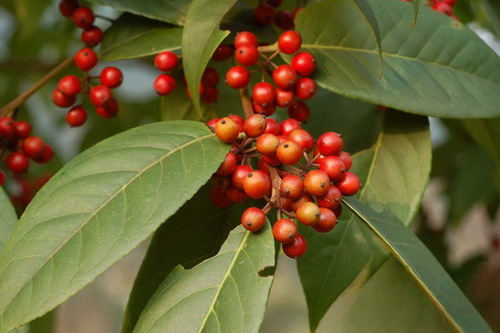
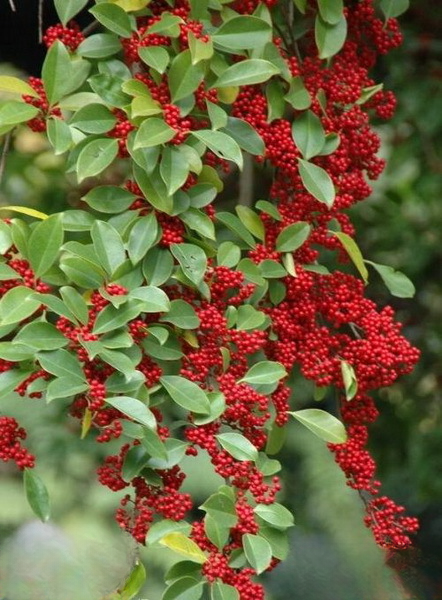
Lotus Magnolia
Family: Magnoliaceae
Genus: Magnolia
Morphological characteristics: The crown is conical, the leaves are thick and leathery, elliptical or obovate-elliptical, dark green and shiny on the surface, and densely covered with rusty hairs on the back. The flowers are solitary at the top of the branches, large, lotus-shaped, white, and fragrant. The aggregate fruit is cylindrical, densely covered with brown or grayish yellow hairs; the follicles are cracked, and the seeds are exposed and red. The flowering period is May-June, and the fruiting period is September-October.
Growth habit: Weakly positive, likes warm and humid climate, resistant to pollution, not tolerant to alkaline soil. Quite shade-tolerant in the seedling stage. Prefers warm and humid climate. Relatively cold-resistant, can withstand short-term low temperatures of -19 degrees. Grows well in fertile, deep, moist and well-drained acidic or neutral soil. The root system is deep and wide, and quite wind-resistant. Few diseases and pests. The growth rate is medium, the seedlings grow slowly, and the growth gradually accelerates after 10 years. Reproduction and cultivation: Reproduction is mainly by sowing and grafting.
Landscape use: Garden, street tree, shade tree Lotus Magnolia has a majestic and magnificent tree shape, large leaves and dense shade, lotus-like flowers, and a rich fragrance. It is a beautiful ornamental tree species for landscaping. It is suitable for solitary planting, clump planting or planting in rows. Lotus Magnolia can also withstand smoke and wind, and has a strong resistance to toxic gases such as sulfur dioxide, so it is also a good tree species for purifying the air and protecting the environment. Both the flowers and leaves can be used as medicine or extract essence.
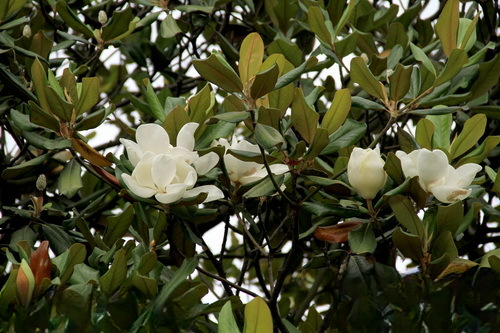
Magnolia
Other names: Magnolia, magnolia, jade tree, winter jasmine, spring, Yingchun flower, Yutangchun, magnolia
Family: Magnoliaceae
Genus: Magnolia
Morphological characteristics: deciduous tree. Flowers are white, large, fragrant, and open before leaves. The flowering period is about 10 days. It is up to 17 meters high, with branches spreading widely and a broad umbrella-shaped crown; the diameter at breast height is 30 cm; the bark is gray; the branches and leaves are fragrant when rubbed; the young branches and buds are densely covered with light yellow-white pubescence, and the pubescence gradually falls off when old. The leaves are thinly leathery, oblong or lanceolate-elliptical, 10-27 cm long, 4-9.5 cm wide, with a long acuminate or caudate-acuminate tip, a cuneate base, glabrous above, sparsely pubescent below, and the reticulate veins on both sides are obvious when dry; the petiole is 1.5-2 cm long and sparsely pubescent; the stipule scar reaches almost the middle of the petiole. The flowers are white and very fragrant; there are 10 perianth segments, lanceolate, 3-4 cm long, 3-5 mm wide; when mature, as the receptacle extends, it forms a sparsely follicled aggregate fruit; the follicles are bright red when mature.
Growth habit: likes warm, sunny, moist and well-drained places, requiring fertile soil without waterlogging. It has strong cold resistance and can safely overwinter at -20℃. It grows well in places with good microenvironment in Beijing. Transplanting should be done more than ten days before germination, or before the leaves unfold after flowering. Another common plant in the north is Magnolia dahurica, with petals lavender on the outside and white on the inside. Winter buds are densely covered with light gray-green long hairs. Leaves are alternate. Flowers bloom before leaves, upright, bell-shaped, fragrant, turquoise white, sometimes with a blush at the base. Aggregate fruit, seeds heart-shaped, black.
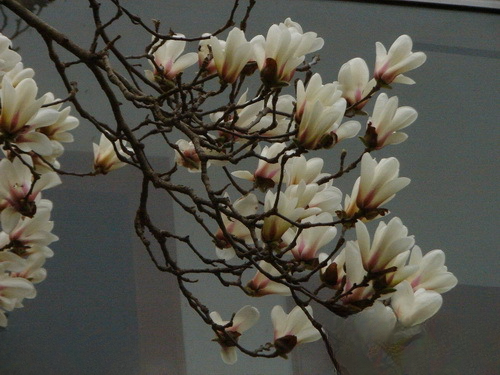
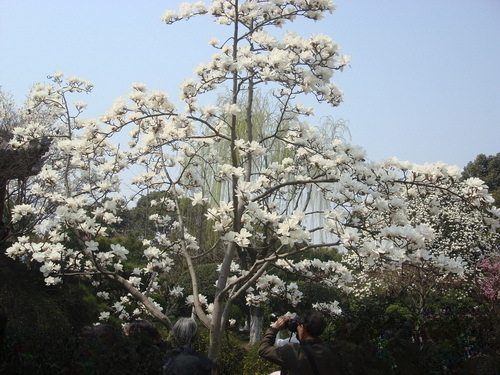
Purple Magnolia
Family: Magnoliaceae
Genus: Magnolia
Characteristics: Deciduous shrub, up to 3 meters tall, often growing in clusters. Buds have gray-brown fine hairs; twigs are purple-brown. Leaves are obovate or elliptic-ovate, 10-18 cm long, 4-10 cm wide, with acute or acuminate apex, cuneate base, and soft hairs along the veins on the back. Flowers open before leaves or rarely at the same time as leaves, large, bell-shaped; sepals are 3, lanceolate, light purple-brown, 2-3 cm long; petals are 6, oblong-obovate, 8-10 cm long, purple or purple-red outside, white inside; filaments and carpels are purple-red; 1 inflorescence, pointed at the apex, slightly curved. Aggregate fruit is oblong, 7-10 cm long, and light brown. Flowering period is April-May.
Growth habits: Purple magnolia likes light and is not shade-tolerant; it is relatively cold-resistant and likes fertile, moist, well-drained soil. It avoids clay soil and is not salt-alkali tolerant; it has fleshy roots and avoids water and humidity; it has a well-developed root system and strong sprouting ability.
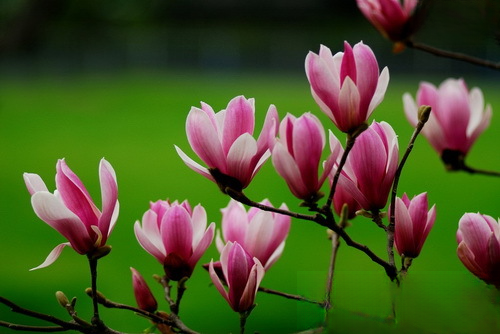
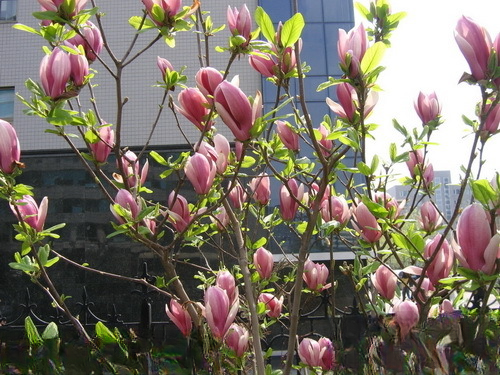
Hainan Syzygium wilfordii
Other names: Zidong tree, ebony, ebony tree
Family: Myrtaceae
Morphological characteristics: General characteristics: Bare tree, up to 8 meters high; branches and twigs are rounded.
Leaves: Leathery, broadly elliptic to broadly rectangular, 6-9 cm long, 3-4.5 cm wide, obtuse or obtusely acuminate at apex, broadly short-pointed or obtuse at base, nearly the same color on both sides, shiny on the upper side, dark on the back, densely veined, convex on both sides, with about 15 pairs of lateral veins, and petiole 1.5-2 cm long.
Flowers: Inflorescences are lateral, rarely axillary or terminal, about 6 cm long, many flowers; flower buds are oblong-obovate, about 5 mm long; flowers are white, sessile, fragrant, calyx tube is gyroid, wrinkled, about 5 mm long, apex is truncated or inconspicuously 4-toothed; petals are separate, round, dome-shaped, 2-2.3 mm in diameter; filaments are 4-5 mm long. Flowering period: spring.
Fruit: The berry is oblique-rectangular or olive-shaped to spherical, purple-red to black, 1-2 cm long and 5-10 mm wide.
Ecological distribution: India via Malaysia to Australia, also produced in the southwest and south.
Note: This species is only cultivated in small quantities on the campus of Sun Yat-sen University in Guangzhou. The wood is white, dense and solid, and is used as lumber. The bark can produce brown dye and dark red resin, and the fruit is edible.
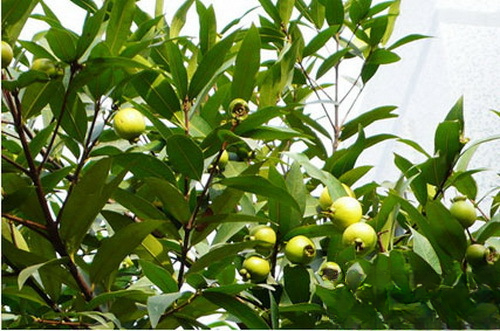
Camphor tree
Family: Lauraceae, Cinnamomum
Other names: camphor, camphor, black camphor, fragrant camphor, camphor, fragrant core, camphor seed
Morphological characteristics: Evergreen tree. It can reach 50 meters in height and be hundreds or thousands of years old. It can be called a towering ancient tree and is an excellent garden greening tree. The bark is green and smooth when young, and gradually turns into yellow-brown or gray-brown longitudinal cracks when old; the winter buds are oval. The leaves are thin leathery, ovate or elliptical-ovate, 5-10 cm long, 3.5-5.5 cm wide, with short tips or nearly tail tips, round base, 3 veins away from the base, the first or second pair of lateral veins near the leaf base are long and obvious, the back is slightly covered with white powder, and there are glandular dots in the vein axils. The flowers are yellow-green, blooming in spring, with axillary panicles, small and numerous. The spherical small fruits are black-purple when mature, with a diameter of about 0.5 cm; the flowering period is April-May, and the fruiting period is October-November. The gray-brown bark has fine deep grooves and longitudinal cracks. The whole plant of camphor has a camphor-like smell, the leaves are alternate, papery or thin leathery, and the trunk has obvious longitudinal cracks, which is very easy to identify. The small flowers of camphor trees are very unique. The flowers have 6 petals that are difficult to distinguish from the calyx or petals on the outside, and 9 stamens in the center, arranged in a whorl of 3. Its evergreen nature does not mean that it does not shed its leaves, but that the old leaves of last year begin to fall off after the new leaves grow in spring, so it is green all year round...
Growth habits: Camphor trees like light and tolerate shade. They like warm and humid climates, are not very cold-resistant, and are not very demanding on soil. They are relatively tolerant to water and humidity, but not to drought, barrenness, and saline-alkali soil. They have well-developed taproots, deep roots, and are wind-resistant. They have strong germination ability and are resistant to pruning. They grow at a medium rate, and their tree shape is huge like an umbrella, which can provide shade and coolness. They have a long survival period and can grow into towering ancient trees that are hundreds or thousands of years old. They have strong abilities to absorb smoke and dust, conserve water resources, consolidate soil and prevent sand, and beautify the environment. In addition, they are resistant to sea tides and winds, smoke and dust, and toxic gases, and can absorb a variety of toxic gases, making them more adaptable to urban environments.
Garden application: This tree species has dense branches and leaves, a large crown and thick shade, and a majestic tree posture. It can absorb smoke and dust, conserve water sources, consolidate soil and prevent sand, and beautify the environment. It is an excellent tree species for urban greening and is widely used as a garden shade tree, street tree, shelter forest and landscape forest. It can be planted by the pool, waterside, hillside, etc. It can be planted in clumps, groups, or alone in the grass or as a background tree.
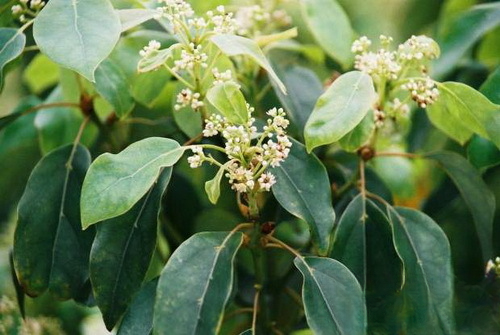
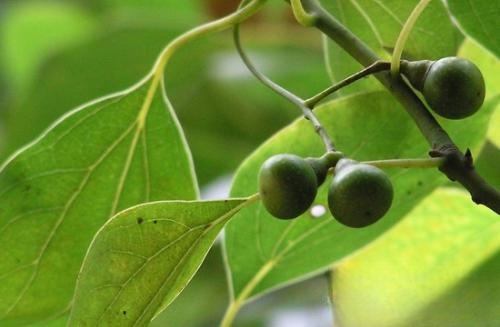
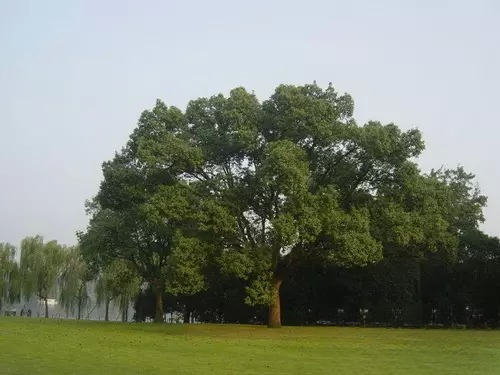
Acer serrata
Family: Araliaceae
Genus: Acer serrata
Other names: snake medicine, Acanthopanax, and Polygonum multiflorum
Morphological characteristics: 8-30m tall, thornless, 3-5 pinnate compound leaves, very large, leaflets opposite, papery, elliptical, glabrous. Most umbels are arranged in large panicles, densely covered with brown star-shaped hairs. Fruits are flat.
Garden use: The tree has a round crown, shaped like an umbrella, and can be used as a garden shade tree or a street tree.
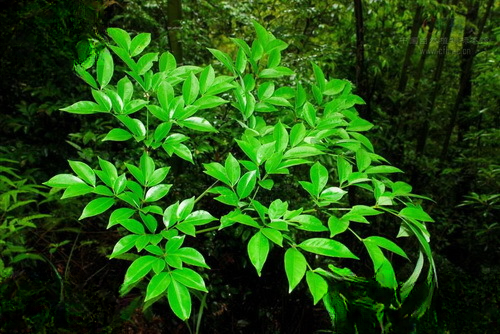
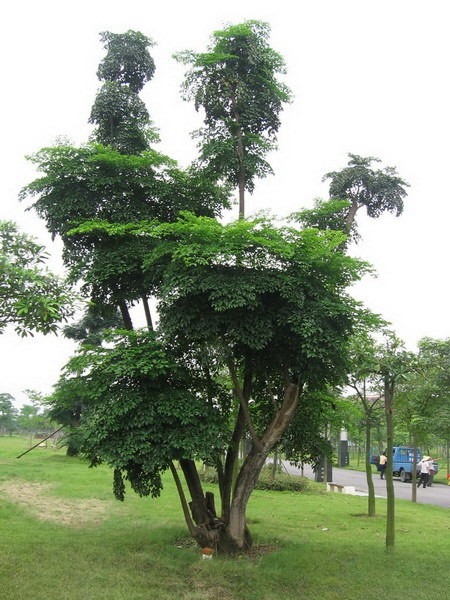
Elaeocarpus hainanensis
Other names: Water stone banyan water willow
Family: Eleutherodactylidae
Genus: Elaeocarpus Origin and Distribution
Morphological characteristics: small evergreen tree. The crown is neatly layered, and the branches are glabrous. The leaves are clustered at the top of the branches, narrowly lanceolate or oblanceolate, 7-375px long, 1.4-2.200px wide, and the petiole is 1-2 cm long. The edges are densely covered with shallow small teeth; the racemes are axillary, shorter than the leaves; the bracts are large, persistent, and broadly ovate; the flowers are large, drooping, white, and fragrant; the sepals are lanceolate; the petals are obovate, with fine cracks at the top like silk; there are many stamens, the top holes are cracked, and there are awn-like protrusions at the top; the ovary is glabrous. The drupe is spindle-shaped, glabrous, and the two ends are gradually pointed like olives and smooth. It likes semi-shade, hot and humid climates, deep roots, strong wind resistance, not cold-resistant, not drought-resistant, likes moisture but not tolerant to waterlogging, and must be planted in moist and well-drained places. Fertile and organic loam is preferred.
Garden use: It has many dense branches, forming a conical crown. It has a long flowering period and a white and elegant crown. It is a common woody flower and suitable for garden landscape trees. It can be used to appreciate flowers and leaves, and is a superior ornamental tree species. It is suitable for planting in lawns, slopes, forest edges, in front of courtyards, and at intersections. It can also be planted as a background tree for other flowers and trees.
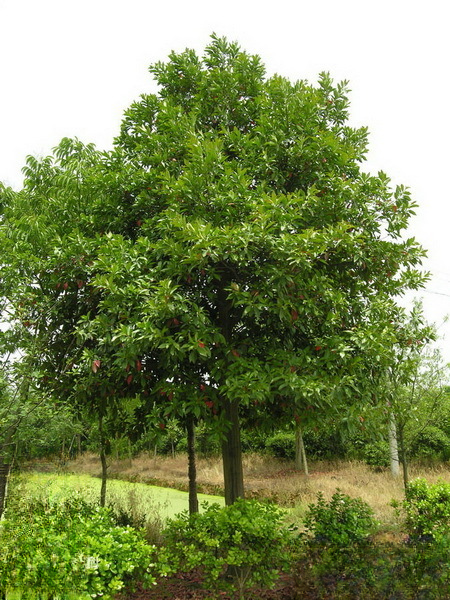
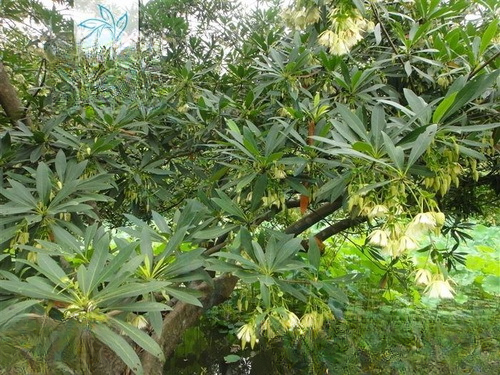
Elaeocarpus acuminata
Other name: Elaeocarpus longifolia
Family: Eleutherodactylaceae
Genus: Elaeocarpus
Ecological habits: Warm-climate tree species, fast-growing, prefers warm and humid environment, suitable for growing in acidic yellow soil, but requires good drainage, with well-developed root system and strong germination ability.
Morphological characteristics: Evergreen tree, up to 30m tall. Branches are thick and gray-brown with soft hairs. Leaves are leathery, obovate-lanceolate, 11-750px long. Racemes grow in the axils of branch tops, petals are white, oblanceolate, with 7-8 lobes at the tip. Drupes are nearly spherical. Flowering period is April-May. There are buttress roots at the base of the roots, and the branches stretch out layer by layer. The whole plant is like a towering spire, majestic and spectacular; when it blooms, it is like hanging layers of white tassels, swaying in the wind, and exuding a creamy aroma, which is lovely.
Garden use: suitable for clumps, patches, or with other trees. The tree is large and vigorous, with dense branches and leaves, and is an evergreen ornamental tree in the garden. In winter, some leaves turn crimson, bright and eye-catching, suitable for clumps, patches, or with other trees. If planted in a row to form a green wall, it has a concealing effect and is also suitable for sound insulation and noise prevention. Suitable for landscape trees and roadside trees.
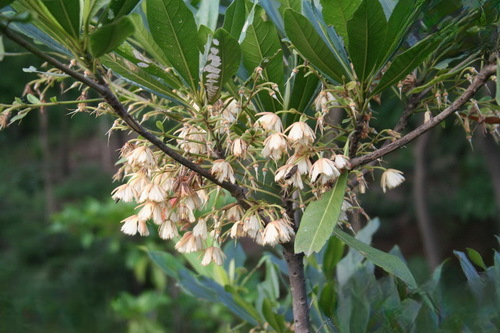
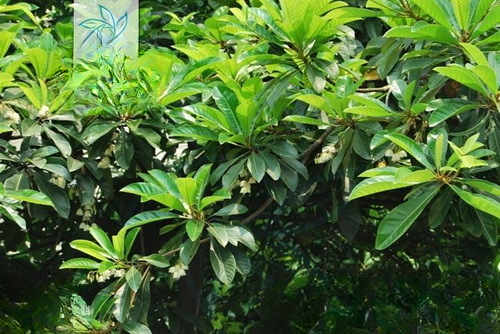
Face
Other names: Human-faced tree, silver lotus fruit
Family: Anacardiaceae, Genus: Anacardia
Distribution of origin: Produced in Guangdong, Guangxi, Hainan, Yunnan and other places, and also in Southeast Asia.
Morphological characteristics: up to 20m tall, with buttress roots. Odd-pinnate compound leaves alternate, 11-17 leaflets, oblong, 6-300px long, entire; panicle, small flowers, green-white, flowering period May-June; drupe spherical and slightly flat, yellow, pit surface concave, shaped like a human face, fruiting period July-August. Evergreen large tree, up to 40cm tall. Leaves alternate, pinnate compound leaves, 1-17 leaflets, pinnules alternate, nearly leathery, oblong, oblong-lanceolate, 6-12cm long, 2.5-4cm wide, entire. Panicle terminal, flowers white, flower diameter 5mm. Drupe flat spherical.
Growth habits: It likes plenty of sunlight, high temperature and humid environment, and is suitable for deep, fertile acidic soil.
Garden use: The tree has a broad and green crown, which is very beautiful. It is an excellent tree species for garden greening and is also suitable as a street tree. The pulp can be processed into candied fruit and jam.
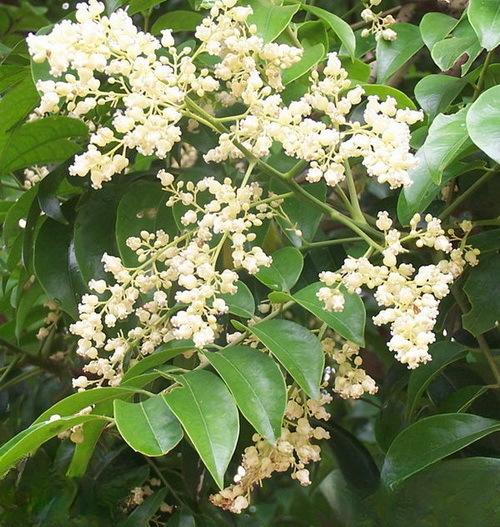
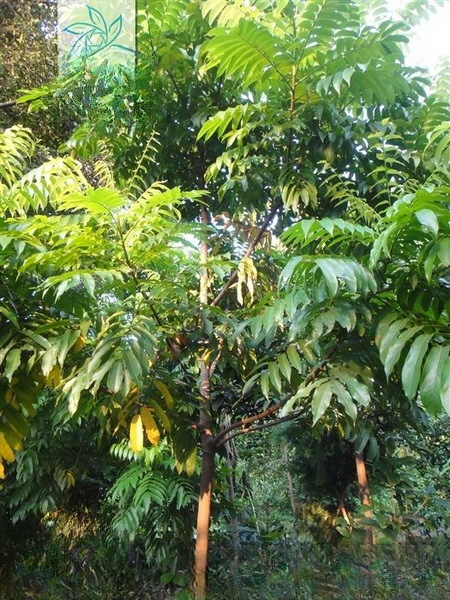
Flame Wood
Bignoniaceae
Origin: Tropical Africa
Morphological characteristics: Evergreen tree, upright trunk, easily branched, round umbrella-shaped crown. Height × crown width: 10m~20m×6~10m (flowers can be bloomed all year round) Texture: medium to coarse Color: Leaves are yellowish green to dark green. Flowers are red or orange-red, rich and bright like fire. Turns to dark brown.
Growth habit: Light: Positive plant, needs strong light. Suitable temperature for growth: 23-30℃ Growth characteristics: Fast growing tropical tree species. Heat-resistant, drought-resistant, moisture-resistant, barren-resistant, brittle branches, not wind-resistant, easy to transplant. Reproduction and cultivation:
Landscape use: The tree is strong and has beautiful flowers. It is suitable for street trees, garden trees, and shade trees. It can be planted alone, in rows, or in groups in gardens, campuses, parks, amusement parks, temples, etc. It is beautiful. It has strong growth in central and southern Taiwan, but is not easy to bloom in the north.
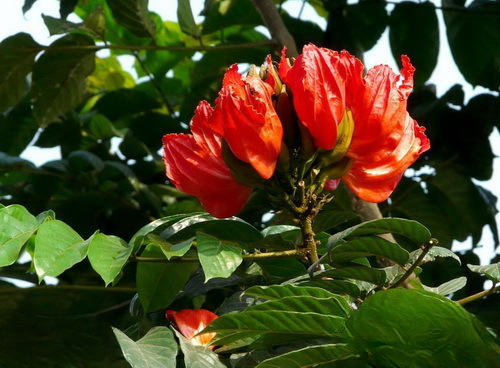
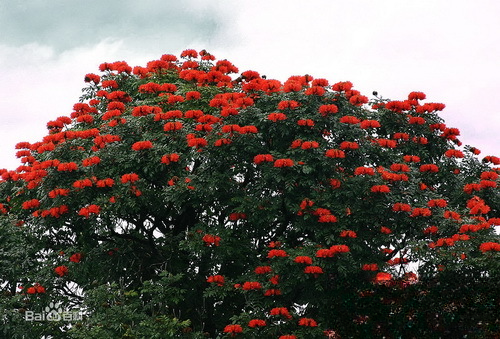
Michelia lechangensis
Other names: Southern White Orchid, Guangdong Michelia, Jinglie White Orchid, Jinglie Michelia Family: Magnoliaceae Genus: Michelia
Origin: Originated from Jiangxi, Hunan, Guangdong, Guangxi, Guizhou, etc.
Morphological characteristics: It is an evergreen tree, 15 to 30 meters high. The bark is gray to dark brown. The leaves are thin leathery, obovate or oblong-obovate, 6.5 to 16 cm long, 3.5 to 7 cm wide, and shiny. It blooms in March and April, and the flowers are light yellow and fragrant. The aggregate fruit is oblong or oval, and the fruit matures in August and September. The seeds are oval or oblong-ovate.
Growth habits: Lechang Michelia prefers warm and humid climates, with a suitable growth temperature of 15-32℃. It can withstand high temperatures of 41℃ and is also cold-resistant. 1-2 year old seedlings will have slight frost damage at low temperatures of -7℃. It likes light, but prefers partial shade during the seedling stage. It prefers deep, loose, fertile, well-drained acidic to slightly alkaline soil. It can tolerate environments with high groundwater levels and grows poorly in overly dry soil.
Use in gardens: The trunk of Lechang Michelia is tall and straight, the shade is dense, and the fragrance of the flowers is intoxicating. It can be planted alone or in groups in the garden, and can also be used as a street tree.
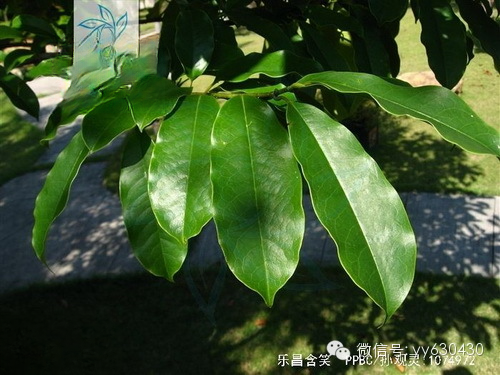
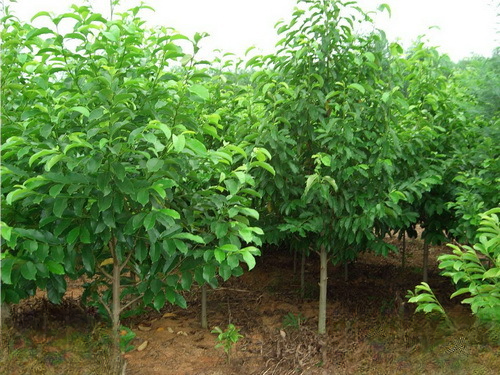
Koelreuteria paniculata
Family: Sapindaceae Koelreuteria
Morphological characteristics: deciduous tree. Up to 15m; crown nearly spherical. Bark is gray-brown with fine longitudinal cracks; twigs are slightly rounded, without terminal buds, with obvious lenticels. Odd-pinnate compound leaves. Small flowers are golden yellow. Capsules are triangular-ovate, orange-red or reddish-brown when mature. Flowering period is June-July, and fruiting period is September. Deciduous tree, up to 20m, crown nearly spherical, bark is gray-brown with fine longitudinal cracks; twigs are slightly rounded, without terminal buds, with obvious lenticels, odd-pinnate compound leaves, sometimes some leaflets are deeply lobed and become incomplete bipinnate compound leaves, up to 1000px long, leaflets are 7-375px, ovate or oblong, with serrated edges or lobes, and short soft hairs along the veins on the back. Large terminal panicles, small golden yellow flowers.
Origin and Habits: Native to the north and central regions. Also distributed in Japan and Korea. Koelreuteria paniculata is a light-loving plant that tolerates partial shade; is cold-resistant; tolerates drought and barrenness, and prefers to grow in calcareous soil. It likes light, tolerates partial shade, tolerates cold, tolerates drought and barrenness. It has strong adaptability and prefers to grow in calcareous soil, and tolerates salinity and short-term waterlogging. It has deep roots, strong sprouting ability, and medium growth rate. Young trees grow slowly, and then gradually faster. It has strong resistance to smoke and dust.
Garden application: With a neat shape and lush and beautiful branches and leaves, it is a good shade tree and roadside tree; the young leaves are mostly red in spring, and turn yellow in autumn, making it an ideal ornamental tree. At the same time, the tree is also a good soil and water conservation and barren hill afforestation tree.
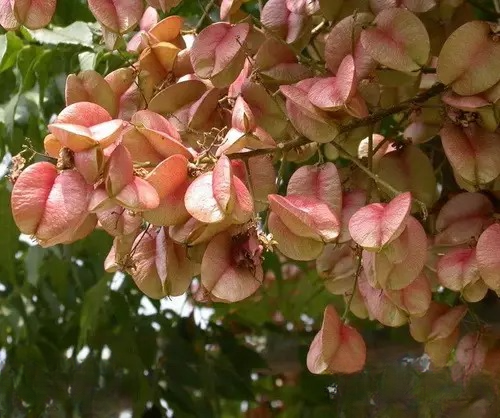
Koelreuteria bipinnata
Other names: Lantern tree, Money tree
Family: Sapindaceae
Genus: Koelreuteria
Morphological characteristics: Deciduous tree with pinnate leaves, terminal conical inflorescence, yellow flowers, red spots at the base of petals, variegated; capsules are ovate, swollen capsules with three edges. The capsules are elliptical, blunt at the top and with short tips. Flowering period is August-September, and fruiting period is October-November. The crown is umbrella-shaped, the flowers are yellow, and the capsules turn red in autumn, which is gorgeous.
Growth habits: It likes light, warm and humid climate, has deep roots, is highly adaptable, is resistant to drought, wind, and air pollution, and grows fast.
Landscape use: shade tree, landscape tree. Koelreuteria paniculata is a deciduous tree, with red leaves in spring, dark green feathery leaves in summer, bright yellow leaves in autumn, and yellow flowers all over the tree. Around National Day, the membranous fruit skin of its capsule swells like a small lantern, bright red, and hangs in clusters on the top of the branches like flowers. It has a strong ability to resist smoke and dust, and is an ideal ornamental tree species for urban greening.
